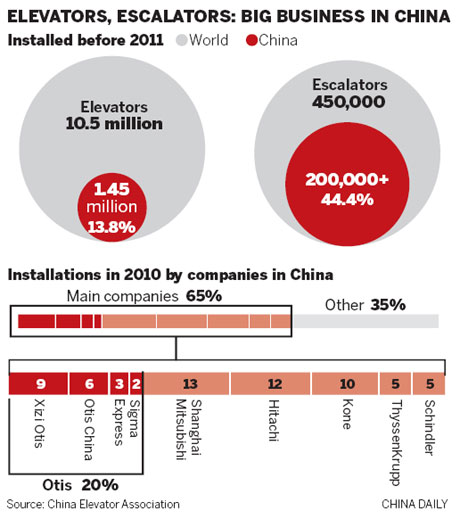Economy
Escalator safety in spotlight
Updated: 2011-07-14 09:57
By Jiang Xueqing (China Daily)
Growing concerns that standards in China are too lax, Jiang Xueqing reports in Langfang, Hebei province.
It took dozens of phone calls, and a train ticket, to eventually locate Zhang Lexiang.
The deputy secretary-general of the China Elevator Association has been the center of media attention after a recent South China Morning Post article about escalator safety. He was quoted as saying, in the article, that subway lines on the Chinese mainland purchased cheap, light-duty escalators designed for shopping malls, instead of heavy-duty escalators, to save money.
 |
He did not expect the brief interview to create such a stir. The reporter called him on July 5, shortly after an ascending escalator on Beijing subway Line 4, an Otis 513 MPE, suddenly reversed. A 13-year-old boy was killed and 30 passengers were injured.
"I don't pick up phone calls from Beijing," he said.
In an e-mail sent to his friends and China Daily, Zhang sought to clarify his position on subway escalators. "My understanding is, compared to heavy-duty escalators, public transport escalators ... are actually light-duty.
"Subway companies should raise standards concerning escalator purchases and choose more sturdy products according to the requirements of Chinese subway system. The buyers should be self-critical, rather than always pointing fingers at escalator manufacturers whenever accidents occur," the e-mail said.
Industry insiders say that the definition of public transport heavy-duty escalators is vague.
Based on its initial investigation, the Beijing Bureau of Quality and Technical Supervision said the Otis 513 MPE had design flaws and the company was inescapably responsible for the accident. The use of all 257 Otis escalators was suspended for inspection.
The accident is still being investigated. The inspectors and experts involved are not allowed to release any information, said Li Shoulin, director of the National Elevator Quality Inspection and Testing Center in Langfang, Hebei province. A news release is planned after the investigation is closed.
Duty ratings
Meanwhile, escalator manufacturers denied that they provide light-duty products for public transport. The Otis global company said on its website that Otis 513 MPE is a heavy-duty public escalator for both indoor and outdoor use and that it was designed to withstand the most punishing treatment.
"I'm responsible for telling you this: All the Otis escalators used in subway projects are heavy-duty escalators. You can tell from the type," said Li Mingjie, spokeswoman for Otis China.
She would not give the price for the Otis 513 MPE.
Zhang said that whether an escalator is a heavy-duty escalator for public transport depends mainly on its specifications. Compared with escalators for commercial buildings, heavy-duty escalators have larger specifications such as track radius to increase the equipment's safety and lifespan.
The American Public Transportation Association requires heavy-duty escalators that rise more than 10 meters to have a minimum of four flat steps at each end and an upper track radius of more than 2.6 meters. As the specifications go higher, product costs increase significantly to meet the demands for long and continuous hours of heavy-duty transport.
"Elevators and escalators are manufactured based on the customers' requirements," Zhang said. "As a result, the products can be widely different."
The Shenzhen subway had a similar accident in December, also involving an Otis 513 MPE. Inspectors have not found any connections between the escalators in Shenzhen and Beijing, because their specifications and structures are different, said Li of Otis China. The specifications were based on the customers' requirements, she said.
The customer in Beijing denied there is such a difference.
"I don't know what you mean by specifications," said Yang Ling, spokeswoman for Beijing MTR Corp. "We have already released information on the specifications of the malfunctioning escalator (in Beijing) on our official website."
A China Daily reporter looked through all five escalator accident briefings and a news conference transcript posted on the company's website July 5-8, but did not find that information.

Specials

90th anniversary of the CPC
The Party has been leading the country and people to prosperity.

The write stuff
'Pen capital' goes back to drawing board for answers to economic changes taking shape in Zhejiang

Say hello to hi panda
An unusual panda is the rising star in Europe's fashion circles
